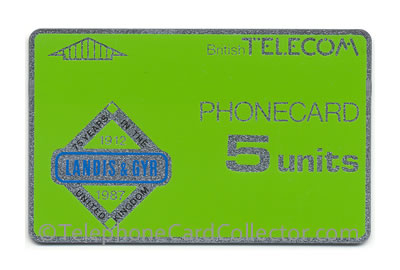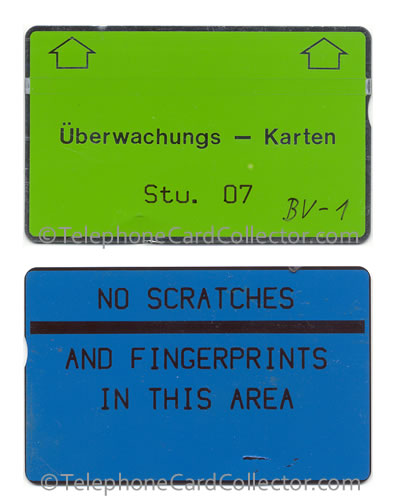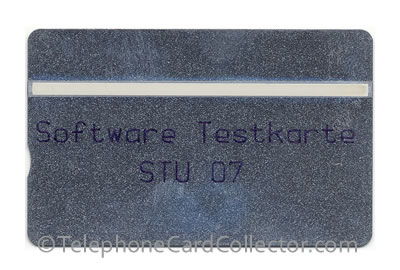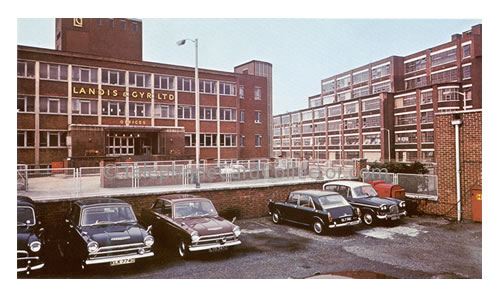Landis & Gyr Structure 7 (STU 07) Great Britain (GB) dummy and test cards
Card manufacturer Landis & Gyr (L&G) produced 'optical' technology based telephone cards for British Telecom (BT) between 1981 and 1998.

Pictured above - BT Phonecard (BTP001) celebrating Landis and Gyr's 75 years in the United Kingdom - 1912 to 1987
Landis & Gyr produced telephone cards for a number of payphone operators around the world. Great Britain (GB) was designated 'Structure 7' or 'STU 07' by Landis & Gyr. This meant that only Phonecards produced and encoded for use in Structure 7 could be used in cardphones in the UK and which BT operated. Thus preventng cards produced for a different country or territory being used in a BT operated cardphone in the UK.
In the early 1980s all of Landis & Gyr's telephone cards were produced in their factory in Zug, Switzerland. From here cards were produced and dispatched all over the world. However, this changed in 1983 when production also started in L&G factory in Acton, London (pictured below) and later in Hsinshu. Taiwan in 1986.
While Landis & Gyr produced millions of Phonecards for British Telecom, the cards pictured below are internal GB and Structure 7 Landis & Gyr cards of which in some cases only a handful of copies are known.
Dummy BTD001 - 10unit - 1st Issue Cardphone Definitive

Pictured above: Front and reverse of dummy BTD001 - 10unit - 1st issue cardphone definitive. This card is NOT encoded (there is no optical strip with encoded cardphone credit) and carries the control number '5 073' on the reverse. It is believed that this card was produced by Landis & Gyr in their factory in Zug, Switzerland and presented as a sample to show British Telecom how the finished BT Phonecard would look and feel. The 40unit, 100unit and 200unit bearing a similar 4 digit control number and that make up the full set of 1st issue cardphone definitive cards are also known to have been produced.
Uberwachungs - Karten - Stu. 07 - 'no notch'

Pictured above: Uberwachungs - Karten without a notch.
Uberwachungs - Karten - Stu. 07 - 'notched'

Pictured above: Front and reverse of 'notched' Uberwachungs - Karten.
The "Uberwachungs Karten" (monitoring cards) were only for use inside the Landis & Gyr factory in Zug, Switzerland. 99% were destroyed and only few pieces survived, maybe 2-3 of each copies. Structure 7 is the optical structure dedicated to GB and this card was used to check the quality of the bulk cards' production. The production costs of überwachungskarten was very high because those cards have a high geometrical quality for its optical structure which is almost perfect.
Only three cards Stu.07 with notches are known. Uberwachungs - Karten were produced with perfect geometry and were only manufactured in Zug, Switzerland and then dispatched to Acton, London (Stu. 07) and Hsinshu, Taiwan (Stu. 15).
Cards were hand-numbered from A-1 ; .... ; A-5 / to / Z-1- ; .... ; Z-5.Each set with a same letter had 5 cards inside. Now it appears that for GB cards were also produced with 2 letters starting with A : AA-1 ; ... ; AA-5 / to / AZ-1 ; ... ; AZ-5 = 130 more cards BA-1 ; ... ; BA-5 / to / BZ-1 ; ... ; BZ-5 = 130 more cards so at least 3x 130 cards for GB = 390 cards.
Known Stu. 07 Uberwachungs cards hand written control numbers (notched and no notch):
Uberwachungskarte Stu.07 no notch with CN "AH-5"
Uberwachungskarte Stu.07 NOTCHED with CN "BV-1"
Uberwachungskarte Stu.07 NOTCHED with CN "CH-1"
GB 40 Einheiten Code 06F

Pictured above: GB 40 Einheiten Code 06F
Software Testkarte STU 07

Pictured above: Software Testkarte STU 07
First thing, the card is written in German and was for sure produced in Zug (CH). In my first opinion the card looks internal and I would say it was for restricted use inside the factory of Zug with Structure 7 BSK readers.
BUT the inverted notch is not by chance and has a meaning! I remember a few Swiss cards issued with inverted notch for use by L&G staff for fullface fieldtrials, outside the factory. Software testing in the field with such cards require readers with Structure 7 and few cards could be used outside the factory in GB, justifying the inverted notch.
Last updated: 27th October 2025
Popular Pages
Collector Shop
Site Maps
TelephoneCardCollector.com © 2013-2025
Please do NOT copy any content without prior consent, thank you.


